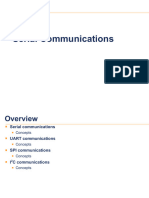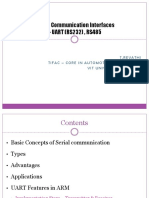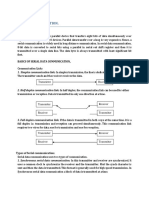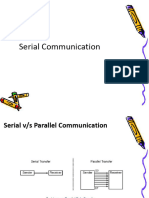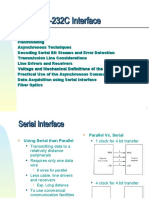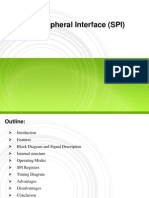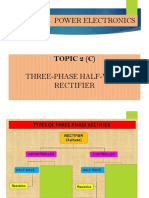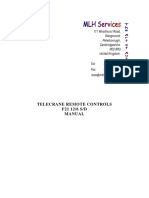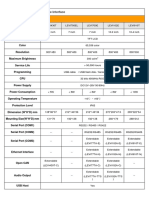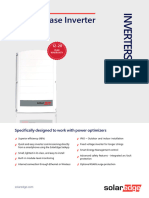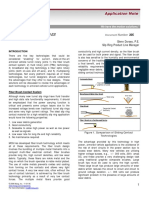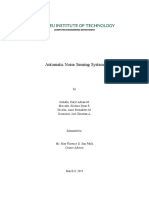Hardware Engineer Guide
For
SERIAL COMMUNICATION
By Shimi Cohen
�Serial Communication Guide
Table of Contents
INTRODUCTION 3
ARCHITECTURE 8
1-WIRE PROTOCOL 11
UART PROTOCOL 14
I²C PROTOCOL 16
SPI PROTOCL 19
USB2.0 PROTOCOL 22
Author Date Version Changes
Shimi Cohen 13/4/2025 1.0 First Draft
-2-
�Serial Communication Guide
INTRODUCTION
Fundamentals
Digital communication transfers data as discrete voltage levels between electronic systems or devices,
revolutionizing hardware engineering by providing reliable, noise-resistant data transfer mechanisms. Unlike
analog transmission, digital methods use discrete voltage levels.
KEY CONCEPTS
A. Logic levels represent binary states (high/low, 1/0)
B. Signal transitions encode data
C. Synchronization aligns transmitter and receiver
REPRESENTATION TECHNIQUES
Non-Return to Zero (NRZ): Maintains voltage level for bit duration
Return to Zero (RZ): Returns to zero between bits
Manchester Encoding Combines clock and data
Differential Manchester: Transition at start, mid-bit transition for 0
SERIAL COMMUNICATION
Serial communication is the dominant method for transferring data between electronic devices. Unlike
parallel communication, which sends multiple bits at once across multiple lines, serial communication
transmits data one bit at a time over a single line or pair of lines, making it more efficient for long distances,
simpler board designs, and noise reduction.
It’s the backbone of everything from debugging tools to sensor networks and high-speed data.
At its core, serial communication protocols define how data is structured, synchronized, and verified during
transmission. They differ in speed, complexity, error handling, and physical layers. From simple byte-
streaming like UART to more complex protocols like USB or Ethernet, each protocol balances tradeoffs in
bandwidth, power, topology, and control. Understanding serial protocols is essential for designing,
debugging, and optimizing embedded systems.
-3-
�Serial Communication Guide
Design Consideration
POWER EFFICIENCY
Strategy Implementation Savings Potential
Clock Gating Disable clocks when idle 30-50%
Voltage Scaling Reduce operating voltage Quadratic reduction
Sleep Modes Power down when inactive 90%+ during idle
Low-Power Signaling Reduced voltage swing Linear with voltage
Data Compression Fewer bits transmitted Proportional to ratio
EMI/EMC CONSIDERATIONS
Electromagnetic compatibility ensures systems operate properly in their intended environment.
EMI Reduction Techniques
Technique Implementation Effect
Differential Signaling Balanced transmission Common mode rejection
Shielding Conductive barriers Direct EM isolation
Filtering Capacitors, ferrites Frequency-selective attenuation
Controlled Impedance Matched traces Reduced reflections/emissions
Spread Spectrum Clocking Frequency modulation Peak emission reduction
Edge Rate Control Slew rate limiting High-frequency content reduction
TRANSMISSIONS MODES
Simplex mode: communication occurs in only one direction — like a one-way street — where one device is
always the transmitter and the other is always the receiver, with no ability to respond.
Half-Duplex mode: allows two-way communication but only one direction at a time; devices must take turns
transmitting and receiving - only one person can speak while the other listens.
Full-Duplex mode: enables simultaneous two-way communication, allowing both devices to send and receive
data at the same time, much like a phone call. Full-duplex systems typically require more complex hardware
to manage the simultaneous flow of data but offer the fastest and most efficient data exchange.
-4-
�Serial Communication Guide
SIGNAL CHARACTERISTICS
The following terms describe the signal behavior and characteristics:
Parameter Description Impact
Rise/Fall Time Time to transition between states Affects maximum frequency
Jitter Timing deviation from ideal Reduces timing margins
Crosstalk Unwanted coupling between signals Creates false transitions
Ringing Oscillations after transitions Can cause false triggers
Reflection Signal bouncing at impedance mismatches Creates standing waves
OPEN-DRAIN VS. PUSH-PULL
Push-Pull Configuration
Push-pull outputs use two transistors (NMOS and PMOS) to actively drive the signal high or low.
High-speed transitions between logic levels and low power consumption during idle states.
Ideal for protocols with dedicated lines for transmission (e.g., TX/RX in UART).
Unidirectional communication lines (e.g., SPI, UART), Common in SPI for clock and data lines.
Open-Drain Configuration
Open-drain outputs use a single transistor (NMOS) to pull the signal low, relying on external pull-up resistors
to achieve a high state. Slower transitions due to pull-up resistor size and bus capacitance, higher power
consumption during active transfers, bidirectional communication lines (e.g., I²C, 1-Wire).
Suitable for multi-device bus systems where multiple devices share the same line.
Common in I²C for SDA/SCL lines and in 1-Wire for data/power sharing.
-5-
�Serial Communication Guide
Clock & Timing
CLOCK RECOVERY METHODS
Technique Method Applications
Edge Detection Timing from signal transitions NRZ with sufficient transitions
PLL/DLL Phase/Delay Locked Loop High-speed serial links
Oversampling Multiple samples per bit Microcontroller UART receivers
Embedded Clock Clock encoded with data Manchester coding
SYNCHRONIZATION CHALLENGES
Challenge Description Mitigation
Frequency Offset Transmitter/receiver clock mismatch PLL tracking, periodic resync
Phase Noise Random timing variations Filtering, averaging
Jitter Accumulation Progressive timing errors Elastic buffers, re-clocking
Initial Acquisition Finding correct bit boundaries Training sequences, preambles
FRAMING AND PACKET STRUCTURE
Successful digital communication requires organizing data into recognizable structures.
Component Purpose Examples
Preamble Synchronization 10101010 pattern, SFD
Start Delimiter Frame boundary identification UART start bit, USB SYNC
Address Field Source/destination identification MAC address, device ID
Control Field Protocol information Frame type, sequence numbers
Data Field Payload information Application data
Error Check Integrity verification CRC, checksum
End Delimiter Frame termination UART stop bits, EOF marker
-6-
�Serial Communication Guide
Common Terminology
Baud Rate Symbols per second
Bit Rate Data bits transmitted per second
Throughput Actual data transfer rate
Latency Delay between Transmit and Receive
Jitter Variation in periodic timing
Duty Cycle Ratio of high time to period
SNR Signal-to-noise ratio
BER Bit error rate
Clock Polarity (CPOL) Defines idle state of clock in SPI; affects how data is sampled.
Clock Phase (CPHA) Determines whether data is sampled on leading or trailing clock edge
Pull-Up Resistor Essential in I2C and 1-Wire to ensure bus lines return to high state.
Bus Arbitration Mechanism in I2C for multiple masters to safely share a single bus.
ACK/NACK Acknowledgement signals in I2C/USB
Start/Stop Condition Specific signal patterns that mark beginning/end of I2C or 1-Wire
Bit Stuffing Technique in USB to prevent long runs of identical bits
Handshake Flow control method to manage data transmission
CRC/Error Checking Methods used in USB and I2C to detect corrupted data
Addressing Scheme Unique device identification method (used in I2C and USB).
Open-Drain Output type that pulls low but leaves line floating high
Line Termination Resistors/circuitry to match impedance and avoid signal reflections.
Flow Control Mechanisms to prevent data overrun in UART.
Bus Contention Error caused when two devices drive the bus simultaneously
Frame Format Structure of transmitted data packet
Transaction A complete data exchange
Enumeration USB process where host detects and assigns address to new device
-7-
�Serial Communication Guide
ARCHITECTURE
Network Configurations
Network topology refers to the physical or logical arrangement of devices within a communication system,
significantly impacting performance, reliability, and scalability.
COMMON NETWORK TOPOLOGIES
Topology Description Advantages Disadvantages
Point-to-Point Direct connection Simple, fast, private Limited scalability
Bus All devices share BUS Easy to implement Contention, single POF
Star Devices connect to hub Easy fault isolation Hub failure affects all
Ring Devices form closed loop Built-in redundancy Complex recovery from failures
Mesh Multiple interconnections High reliability Complex, resource-intensive
Tree Hierarchical arrangement Scalable Dependent on root node
PHYSICAL IMPLEMENTATION CONSIDERATIONS
When implementing a specific topology, hardware engineers must consider the following:
Transmission Medium: Copper, fiber, wireless capabilities
Maximum Distance: Cable length limitations based on medium
EMI Susceptibility: Environmental noise considerations
Power Requirements: Particularly for active components
Connector Types: Physical durability and connection reliability
Expandability: Future growth accommodation
IMPEDANCE-MATCHING TECHNIQUES
Series Termination: Resistor at source end absorbs reflections
Parallel Termination: Resistor at destination matches line impedance
AC Termination: RC network provides frequency-dependent termination
Differential Termination: Resistor between differential pairs
-8-
�Serial Communication Guide
Control Hierarchies
Control hierarchies establish the relationship between communicating devices.
MASTER-SLAVE ARCHITECTURE
In master-slave configurations, a single master controls all communication.
Characteristic Description
Initiation Only the master can initiate COMM
Addressing Master specifies target slave device
Contention No collisions (master controlled)
Complexity Simple slave implementation
Examples I²C, SPI, 1-Wire
PEER-TO-PEER ARCHITECTURE
Peer-to-peer systems allow any device to initiate communication with others.
Characteristic Description
Initiation Any device can initiate communication
Addressing Direct addressing between peers
Contention Requires collision detection/avoidance
Complexity All devices equally complex
Examples UART, 1-Wire
MULTI-MASTER ARCHITECTURE
Multi-master systems combine elements of both approaches, allowing multiple devices to act as masters.
Characteristic Description
Initiation Multiple devices can initiate
Addressing Masters address target devices
Contention Requires arbitration mechanism
Complexity Moderate to high
Examples I2C, 1-Wire
-9-
�Serial Communication Guide
Synchronous vs. Asynchronous
SYNCHRONOUS COMMUNICATION
Synchronous protocols use a shared clock signal to coordinate data transmission and reception.
Clock Distribution: Either separate clock line or embedded in data
Tight Timing: Reduces overhead but requires precision
Examples: SPI, I²C, JTAG
Synchronous Communication Characteristics
Aspect Implementation Benefits
Timing Clock line or embedded clock Precise timing control
Speed Generally higher throughput Efficient for bulk data
Overhead Minimal protocol overhead More efficient bandwidth use
Distance Usually, shorter maximum distances Simpler circuitry
Complexity Clock skew management required Predictable timing
ASYNCHRONOUS COMMUNICATION
Asynchronous methods operate without a shared clock, using start/stop bits and agreed-upon baud rates.
Start/Stop Framing: Marks beginning and end of data units
Clock Recovery: The Receiver derives timing from data transitions
Examples: UART, RS-232, RS-485
Asynchronous Communication Characteristics
Aspect Implementation Benefits
Timing Self-clocking with start/stop bits No clock distribution needed
Speed Generally lower throughput More robust over distance
Overhead Higher due to framing bits Simpler implementation
Distance Can achieve longer distances Greater timing flexibility
Complexity Baud rate matching required Easier to implement
- 10 -
�Serial Communication Guide
1-WIRE PROTOCOL
Single -Wire Interface
Developed by Dallas Semiconductor (now Maxim Integrated), 1-Wire provides bidirectional communication
over a single data line plus ground reference.
1-WIRE PINOUT
Signal Function Electrical Characteristics
DQ Data/Power Line Open drain with pull-up resistor
GND Signal Ground Common reference
PULL-UP RESISTOR
Bus Length Standard Speed Overdrive Speed
<10m 4.7kΩ 2.2kΩ
10-20m 3.3kΩ Not recommended
20-100m Active pull-up Not recommended
Parasitic Power: The 1-Wire interface often includes optional weak parasitic power. Master provides strong pull-up (≤1kΩ) during
specific operations and slaves can draw power from data line during inactive periods.
LAYOUT TOPOLOGIES
Linear Topology: Devices along single bus with short stubs
Star Topology: Multiple branches from central point (limited)
- 11 -
�Serial Communication Guide
Timing and Signaling
1-Wire uses precisely timed signal transitions to encode data and commands.
SPEED MODES
Parameter Standard Overdrive
Bit Rate 15.4 kbps 125 kbps
Reset Recovery 480 μSec 48 μSec
Time Slot 60-120 μSec 6-12 μSec
Sample Window 15 μSec 2 μSec
Max Network Size 100+ devices 10-20 devices
BASIC SIGNALING ELEMENTS
Signal Master Action Standard Overdrive
Reset Pulse Pull bus low 480-640 μSec 48-80 μSec
Presence Detect Release bus, sample 60-240 μSec 6-24 μSec
Write 0 Pull low for entire slot 60-120 μSec 6-12 μSec
Write 1 Pull low briefly, release 1-15 μSec low 1-2 μSec low
Read Bit Pull low briefly, sample Sample at 15 μSec Sample at 2 μSec
Recovery Time Bus idle between slots 1 μSec 1 μSec
- 12 -
�Serial Communication Guide
Device Addressing
Every 1-Wire device contains a globally unique 64-bit ROM registration number for addressing.
ROM CODE STRUCTURE
Field Size Purpose
Family Code 8 bits Identifies device type
Serial Number 48 bits Unique device identifier
CRC 8 bits Error detection for previous 56 bits
ROM COMMAND SET
Command Code Function
READ ROM 0x33 Reads 64-bit ROM code (single device only)
MATCH ROM 0x55 Addresses specific device by ROM code
SKIP ROM 0xCC Addresses all devices simultaneously
SEARCH ROM 0xF0 Algorithm to identify all devices on bus
ALARM SEARCH 0xEC Identifies devices in alarm state
RESUME 0xA5 Addresses last device selected
SEARCH ALGORITHM IMPLEMENTATION
The Search ROM (0xF0) command uses a binary tree approach:
1. Master issues Search ROM command
2. For each bit position (0-63):
a. Read bit value
b. Read complement of bit value
c. Based on responses, write direction bit
3. Process builds complete ROM codes iteratively
4. CRC verifies correct reading
5. Algorithm continues until all devices are discovered
- 13 -
�Serial Communication Guide
UART PROTOCOL
Hardware Implementation
UART (Universal Asynchronous Receiver/Transmitter) is a core serial communication method widely used in
embedded systems. While traditionally used for direct device-to-device links, modern systems often embed
UART inside other protocols to enhance compatibility or range. A common case is USB-to-UART bridges
(e.g., FTDI, CP210x), enabling UART over USB. This approach is known as protocol tunneling or
encapsulation. UART is also tunneled via Ethernet using serial-over-IP.
UART PINOUT
UART uses inverted logic, where the idle line is high (logic 1) and active state is low (logic 0). This setup
allows easy break detection and ensures clean synchronization during transmission.
RTS and CTS are optional flow control lines. While TX, RX, and GND are enough for basic UART operation,
adding RTS/CTS enhances reliability, especially in high-speed or buffered systems, by managing data flow
and preventing overruns.
Signal Direction Function
TX Output Transmits serial data
RX Input Receives serial data
RTS Output Request to Send (flow control)
CTS Input Clear to Send (flow control)
GND NA Signal ground reference
- 14 -
�Serial Communication Guide
Frame Structure
UART frames encapsulate data with specific control bits to ensure reliable transmission without a clock.
STANDARD UART FRAME
The standard configuration for modern systems is "8N1" (i.e., 8 data bits, no parity, 1 stop bit).
Field Size Purpose
Start Bit 1 bit Always logic 0, marks frame start
Data Bits 8 bits Payload
Parity Bit 1 bit Optional error detection
Stop Bits 1 bits Always logic 1, marks frame end
PARITY BIT (OPTIONAL)
Parity provides basic error detection capabilities.
No Parity: One Symbol is 10Bits (and not 11Bits)
Even Parity: The Total number of 1s must be even
Odd Parity: The Total number of 1s must be odd
TIMING CONSIDERATIONS
Parameter Calculation Impact
Bit Time 1 / Baud Rate Defines timing window
Frame Time (1 + Data Bits + Parity + Stop Bits) × Bit Time Total transmission time
Sampling Point Middle of bit period Minimizes edge timing effects
Baud Rate Error Difference between actual and nominal rates Causes framing errors above ~2%
- 15 -
�Serial Communication Guide
I²C PROTOCOL
Two -Wire Interface
Inter-Integrated Circuit (I²C) provides a simple, low-speed, two-wire interface.
I²C PINOUT
Signal Function Electrical Characteristics
SDA Serial Data Line Bidirectional, open-drain/open-collector
SCL Serial Clock Line Typically controlled by master, open drain
VCC Supply Voltage Power reference
GND Ground Signal reference
PULL-UP RESISTOR SELECTION
Pull-up resistors must balance between:
Low enough for fast rise time (RC time constant)
High enough to limit current when lines are driven low
Bus Capacitance @100 kHz @400 kHz @1 MHz
100 pF 4.7 KΩ 3.3 KΩ 1.0 KΩ
200 pF 3.3 KΩ 2.2 KΩ 620 Ω
300 pF 2.2 KΩ 1.5 KΩ 470 Ω
400 pF 1.8 KΩ 1.2 KΩ 330 Ω
SPEED GRADES AND TIMING
Mode Max Clock Frequency Rise Time (max) Fall Time (max)
Standard Mode 100 kHz 1000 ns 300 ns
Fast Mode 400 kHz 300 ns 300 ns
Fast Mode Plus 1 MHz 120 ns 120 ns
High Speed Mode 3.4 MHz 40 ns 40 ns
- 16 -
�Serial Communication Guide
Addressing and Arbitration
I²C uses a 7-bit addressing scheme (expandable to 10 bits) to support multiple devices on the same bus.
I²C SEQUENCE
Operation Description Direction
START Condition SDA transitions high-to-low while SCL high Master → All
STOP Condition SDA transitions low-to-high while SCL high Master → All
ACK Receiver pulls SDA low during 9th clock pulse Receiver → Transmitter
NACK Receiver leaves SDA high during 9th clock pulse Receiver → Transmitter
Address Frame 7-bit address + 1 R/W bit + 1 ACK/NACK Master → Slave
Data Frame 8 data bits + 1 ACK/NACK Either direction
I²C PACKET
The packet of standard I2C communication:
MULTI-MASTER ARBITRATION
When multiple masters attempt simultaneous transmission:
(This collision detection occurs without corruption of data on the bus)
All masters monitor SDA while transmitting
If the expected level differs from the actual level, arbitration lost
SDA acts as wired-AND (low wins)
Losing master switches to slave mode
Winning master continues undisturbed
- 17 -
�Serial Communication Guide
Advanced Protocol Features
I²C includes several advanced features for complex system requirements.
CLOCK STRETCHING
Allows slower slaves to control communication pace:
Slave holds SCL low after receiving or sending byte
Master detects SCL held low
Master waits for SCL to release
Communication resumes when slave releases SCL
10-BIT ADDRESSING
Extends address space to support more devices:
First byte: 11110XX + R/W bit (XX = top 2 bits of address)
Second byte: Remaining 8 bits of address
For reads, requires repeated START condition
GENERAL CALL
Broadcast commands to all devices:
Address byte is 0x00 followed by R/W=0
Second byte contains command code
Devices that support general call will ACK
DEVICE ID
Allows enumeration of devices on bus:
Special address 0x7C followed by R/W=1
Device responds with 3-byte ID sequence
Useful for dynamic configuration
- 18 -
�Serial Communication Guide
SPI PROTOCL
Four -Wire Interface
Serial Peripheral Interface (SPI) provides high-speed, full-duplex communication between a master and
multiple slave devices.
SPI PINOUT
Unlike I²C, SPI uses push-pull drivers for all signals, enabling faster speeds without pull-up resistors
Signal Alternative Names Function
MOSI SDI, DI, SI Master Out Slave In
MISO SDO, DO, SO Master In Slave Out
SCLK SCK, CLK Serial Clock
CS/SS NSS, CE Chip Select/Slave Select
GND NA Signal ground reference
ELECTRICAL CHARACTERISTICS
Supply Voltage Logic Low Logic High Rise/Fall Times
3.3V 0-0.8V 2.0-3.3V <10ns typical
5.0V 0-1.0V 3.5-5.0V <10ns typical
ADVANTAGES OVER OTHER PROTOCOLS
Amongst the Serial protocols, SPI is usually preferable, due to the following attributes:
Full-Duplex: Simultaneous bidirectional data transfer
No Addressing Overhead: Dedicated CS lines select devices
Higher Speed: Multi-MHz to >50MHz operation
Flexible Packet Size: No fixed word length
Simple Hardware: No complex state machines are required
Low Latency: Minimal protocol overhead
- 19 -
�Serial Communication Guide
SPI Configurations
SPI supports multiple slave devices using different wiring configurations.
INDEPENDENT SLAVE SELECT
Most common configuration with dedicated CS line per slave.
On one hand: Simple implementation, independent device operation, No software overhead.
But on the other: More complex PCB routing, Limited scalability and uses more I/O pins
DAISY-CHAIN CONFIGURATION
Advantages: Uses only one CS line, Simplified routing, Good for distribution systems
Disadvantages: Increased latency, Complex data handling, all devices must use same protocol
Devices connected in series with data propagating through chain as followed:
MOSI connects to first device's data input
Each device's data output connects to next device's input
Last device's output connects to master's MISO
Single CS line activates all devices simultaneously
QUAD SPI
Quad SPI (QSPI) is an enhanced version of SPI that boosts bandwidth by using four data lines (IO0–IO3)
instead of just one (MOSI). While standard SPI transmits 1 bit per clock, QSPI can transmit 4 bits per clock
cycle, effectively quadrupling the data rate without increasing the clock speed. This makes it ideal for high-
speed memory access, like reading from NOR flash in embedded systems. QSPI maintains the same clock
and chip select lines as SPI but shifts into higher bit modes after an initial command phase, offering
backward compatibility with standard SPI devices.
- 20 -
�Serial Communication Guide
CLOCK POLARITY AND PHASE
SPI offers four operating modes based on clock polarity (CPOL) and phase (CPHA) settings.
Mode CPOL CPHA Clock Idle State Data Capture Edge
0 0 0 Low Rising
1 0 1 Low Falling
2 1 0 High Falling
3 1 1 High Rising
Mode 0 (CPOL=0, CPHA=0):
Clock idles low
Data sampled on rising edge
Data changes on falling edge
Mode 1 (CPOL=0, CPHA=1):
Clock idles low
Data sampled on falling edge
Data changes on rising edge
Mode 2 (CPOL=1, CPHA=0):
Clock idles high
Data sampled on falling edge
Data changes on rising edge
Mode 3 (CPOL=1, CPHA=1):
Clock idles high
Data sampled on rising edge
Data changes on falling edge
DEVICE COMPATIBILITY CONSIDERATIONS
When interfacing different SPI devices:
• Master must reconfigure for each device if modes differ
• Typically handled through software control of CPOL/CPHA bits
• Some controllers support changing mode between CS assertions
• Devices with same mode can share clock and data lines
- 21 -
�Serial Communication Guide
USB2.0 PROTOCOL
Physical Layer and Speed Grades
Universal Serial Bus (USB) provides a standardized interface for connecting peripherals to host systems.
USB PINOUT
Signal Function Description
VBUS Power 5V supply from host
D+ Data Plus Differential data signal
D- Data Minus Differential data signal
ID Mode Detect )OTG) Single Ended
GND Ground Signal reference
USB CONNECTOR TYPES
Connector Usage Max Current Compatible
Type-A Host ports 500mA-900mA USB 1.0-3.2
Type-B Peripheral ports N/A USB 1.0-3.2
Mini-B Smaller peripherals 500mA USB 1.0-2.0
Micro-B Mobile devices 500mA-900mA USB 1.0-3.0
Type-C Newer devices Up to 5A USB 2.0-4.0
USB SPEED GRADES
Speed Grade Data Rate Signaling Cable Requirements
Low Speed 1.5 Mbps Single-ended 2 twisted pairs
Full Speed 12 Mbps Single-ended 2 twisted pairs
High Speed 480 Mbps Differential 2 twisted pairs, shielded
- 22 -
�Serial Communication Guide
Enumeration Process
USB enumeration allows the host to identify and configure connected devices.
ENUMERATION STEPS
1. Device Connection: Host detects voltage change on data lines
2. Reset: Host sends reset signal (SE0 for >10ms)
3. Speed Detection: Device pulls up D+ (full speed) or D- (low speed)
4. Default Address: Device assigned address 0 initially
5. Descriptor Request: Host requests device descriptor
6. Address Assignment: Host assigns unique address
7. Configuration: Host selects device configuration
8. Driver Loading: OS loads appropriate driver
USB DESCRIPTORS HIERARCHY
Descriptor Purpose Key Information
Device Basic device info Class, VID, PID, versions
Configuration Power requirements Max power, bus/self-powered
Interface Functional group Class, subclass, protocol
Endpoint Communications channel Direction, type, max packet size
String Human-readable info Manufacturer, product names
HID Human interface data Report format
BOS Platform capabilities USB versions, device capabilities
DEVICE CLASSES
Class Code Typical Devices
HID 0x03 Keyboards, mice, gamepads
CDC 0x02/0x0A Modems, serial adapters
Mass Storage 0x08 Flash drives, external drives
Audio 0x01 Headsets, speakers
Video 0x0E Webcams, capture devices
Printer 0x07 Printers
Hub 0x09 USB hubs
- 23 -
�Serial Communication Guide
Transfer Types
USB supports four transfer types for different communication requirements.
CONTROL TRANSFERS
Used for command and status operations:
• Mandatory for all devices
• Structured as SETUP + optional DATA + STATUS phases
• Always uses endpoint 0
• Used for enumeration and standard requests
BULK TRANSFERS
Designed for large, non-time-critical data:
• Variable packet size (8-1024 bytes depending on speed)
• Error detection and retransmission
• No bandwidth guarantee
• Common for storage devices, printers
INTERRUPT TRANSFERS
Provides guaranteed latency for periodic small transfers:
• Fixed maximum latency (1-255ms)
• Guaranteed bandwidth
• Error detection and retry
• Common for HID devices (keyboards, mice)
ISOCHRONOUS TRANSFERS
For time-critical data streams:
• Guaranteed bandwidth
• No error correction (data loss accepted)
• Fixed packet size per frame
• Common for audio/video streaming
- 24 -





